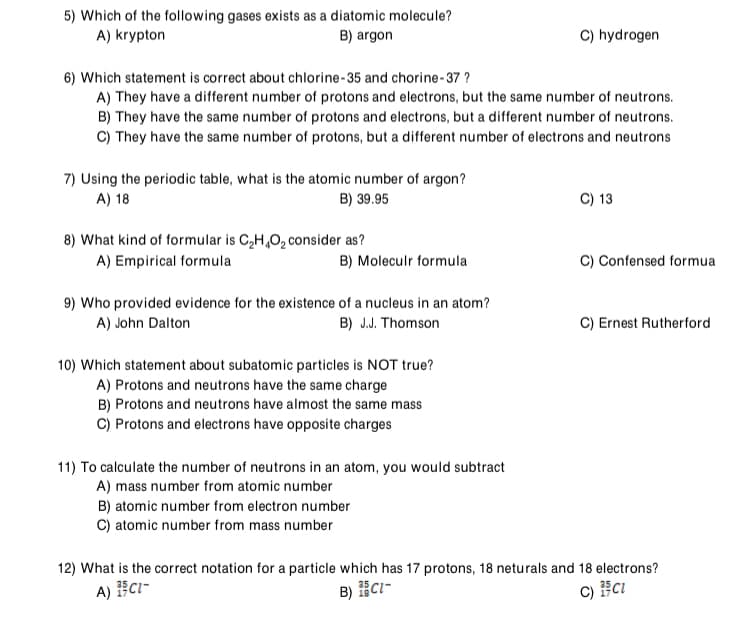Chemistry by OpenStax (2015-05-04)
1st Edition
ISBN:9781938168390
Author:Klaus Theopold, Richard H Langley, Paul Flowers, William R. Robinson, Mark Blaser
Publisher:Klaus Theopold, Richard H Langley, Paul Flowers, William R. Robinson, Mark Blaser
Chapter2: Atoms, Molecules, And Ions
Section: Chapter Questions
Problem 21E: Click on the site (http://openstaxcollege.org/l/16PhetAtomMass) and select the Mix Isotopes tab,...
Related questions
Question

Transcribed Image Text:5) Which of the following gases exists as a diatomic molecule?
A) krypton
C) hydrogen
B) argon
6) Which statement is correct about chlorine-35 and chorine-37 ?
A) They have a different number of protons and electrons, but the same number of neutrons.
B) They have the same number of protons and electrons, but a different number of neutrons.
C) They have the same number of protons, but a different number of electrons and neutrons
7) Using the periodic table, what is the atomic number of argon?
A) 18
B) 39.95
C) 13
8) What kind of formular is C,H,0, consider as?
A) Empirical formula
C) Confensed formua
B) Moleculr formula
9) Who provided evidence for the existence of a nucleus in an atom?
A) John Dalton
C) Ernest Rutherford
B) J.J. Thomson
10) Which statement about subatomic particles is NOT true?
A) Protons and neutrons have the same charge
B) Protons and neutrons have almost the same mass
C) Protons and electrons have opposite charges
11) To calculate the number of neutrons in an atom, you would subtract
A) mass number from atomic number
B) atomic number from electron number
C) atomic number from mass number
12) What is the correct notation for a particle which has 17 protons, 18 neturals and 18 electrons?
A) Ci-
B) CI-
Expert Solution
This question has been solved!
Explore an expertly crafted, step-by-step solution for a thorough understanding of key concepts.
This is a popular solution!
Trending now
This is a popular solution!
Step by step
Solved in 2 steps with 2 images

Knowledge Booster
Learn more about
Need a deep-dive on the concept behind this application? Look no further. Learn more about this topic, chemistry and related others by exploring similar questions and additional content below.Recommended textbooks for you

Chemistry by OpenStax (2015-05-04)
Chemistry
ISBN:
9781938168390
Author:
Klaus Theopold, Richard H Langley, Paul Flowers, William R. Robinson, Mark Blaser
Publisher:
OpenStax

Chemistry: The Molecular Science
Chemistry
ISBN:
9781285199047
Author:
John W. Moore, Conrad L. Stanitski
Publisher:
Cengage Learning

Chemistry: Principles and Reactions
Chemistry
ISBN:
9781305079373
Author:
William L. Masterton, Cecile N. Hurley
Publisher:
Cengage Learning

Chemistry by OpenStax (2015-05-04)
Chemistry
ISBN:
9781938168390
Author:
Klaus Theopold, Richard H Langley, Paul Flowers, William R. Robinson, Mark Blaser
Publisher:
OpenStax

Chemistry: The Molecular Science
Chemistry
ISBN:
9781285199047
Author:
John W. Moore, Conrad L. Stanitski
Publisher:
Cengage Learning

Chemistry: Principles and Reactions
Chemistry
ISBN:
9781305079373
Author:
William L. Masterton, Cecile N. Hurley
Publisher:
Cengage Learning


Chemistry
Chemistry
ISBN:
9781305957404
Author:
Steven S. Zumdahl, Susan A. Zumdahl, Donald J. DeCoste
Publisher:
Cengage Learning

Introductory Chemistry: A Foundation
Chemistry
ISBN:
9781337399425
Author:
Steven S. Zumdahl, Donald J. DeCoste
Publisher:
Cengage Learning